Argo Navis (the Ship Argo) is an obsolete constellation located in the southern sky. It is the only Greek constellation that was not included among the 88 modern constellations when the constellation boundaries were defined by the International Astronomical Union (IAU) in the 1920s. Argo was divided into three smaller constellations – Carina (the Keel), Puppis (the Stern or Poop Deck) and Vela (the Sails) – by the French astronomer Nicolas-Louis de Lacaille in the 18th century.
In Greek mythology, Argo Navis represents Argo, the ship on which Jason and the Argonauts sailed to Colchis in search of the Golden Fleece. The name Argonauts comes from the name of the ship.
Before it was divided, Argo Navis was the largest constellation in the sky. Stretching across 1667 square degrees, it was 28% larger than Hydra, the second largest constellation at the time. Hydra, the largest of the modern 88 constellations, occupies an area of 1303 square degrees.
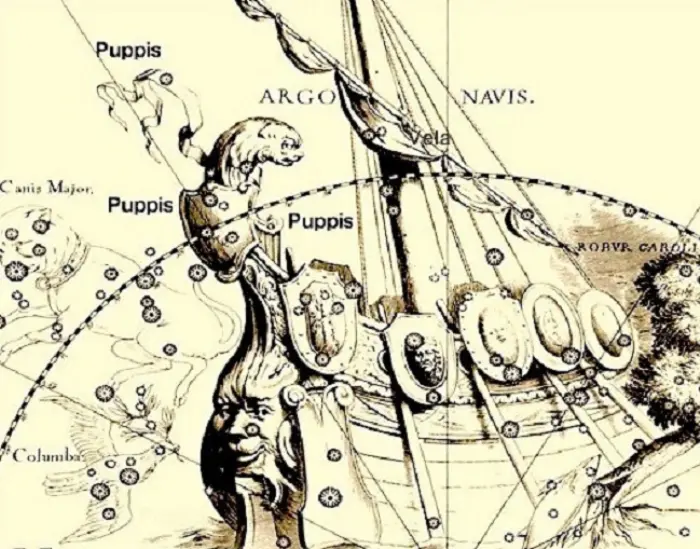
Argo Navis as depicted by Johannes Hevelius in Prodromus Astronomiae (1690)
In classical antiquity, most of Argo Navis was visible from the mid-northern latitudes. The Greco-Roman astronomer Claudius Ptolemy, who catalogued it as one of the 48 Greek constellations in the 2nd century CE, was able to see it from Alexandria.
However, due to the precession of the equinoxes, the constellation’s stars appear to have shifted southward and became largely invisible to European observers. Some of the bright stars of Puppis and Vela may be spotted from Mediterranean latitudes in spring and winter, but Carina is only visible from the tropical latitudes and in the southern hemisphere.
Mythology
In Greek mythology, Argo was a ship commissioned by King Pelias of Iolcus in Thessaly to help Jason and the Argonauts sail to Colchis on the southeast coast of the Black Sea and retrieve the Golden Fleece.
The vessel was built by Argus, a shipwright and one of the Argonauts, under the guidance of the goddess Athena. It was large enough for 50 men and designed to travel in the open sea. Argus placed a piece of a sacred oak from the grove of Zeus at Dodona on the ship’s prow. It is said that the piece of wood was able to advise Jason and warn him of danger.
The best description of the boat comes from Argonautica, a Greek epic poem written by Apollonius Rhodius in the 3rd century BC. Argo had 50 oars and looked like an early version of a penteconter, an ancient Greek galley.
The Golden Fleece was a symbol of royal power and kingship. It was the fleece of the golden ram that saved Phryxus, the son the king of Boeotia and brother of Helle, and brought him safely back to Colchis. In Colchis, the ram was sacrificed to the gods. It is represented by the constellation Aries. Phryxus’ sister Helle did not survive the journey. She fell into the strait that was later named after her, the Hellespont (now the Dardanelles).
King Pelias set Jason on the quest to get the Golden Fleece in order to rightfully place the latter on the throne of Iolcus. However, Pelias did not believe that the expedition would be a successful one because he knew that Aeëtes, the king of Colchis, would not part with it easily.
The Golden Fleece was kept in a sacred grove and guarded by a never-sleeping dragon. Jason was able to retrieve it with the help of Medea, the daughter of King Aeëtes. Medea put the dragon to sleep with herbs, allowing Jason to take the fleece.
After the successful journey, the ship was consecrated to Poseidon and made into a monument. It was placed into the sky as the constellation Argo Navis.
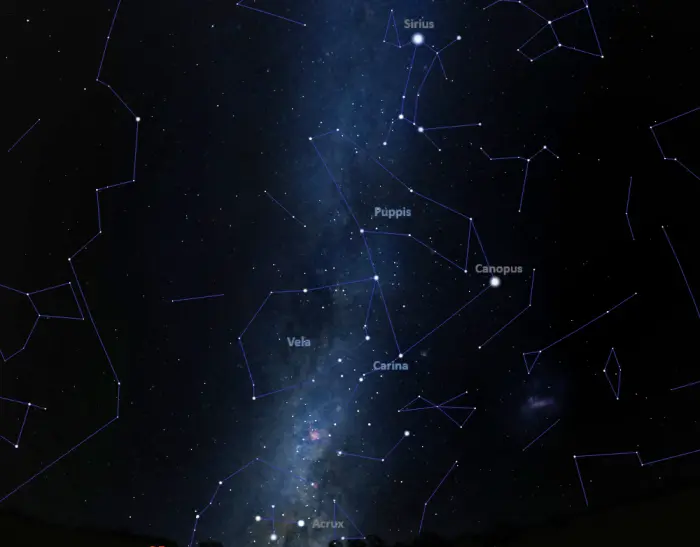
Argo Navis and the Milky Way, image: Stellarium
Many members of Jason’s crew were famous heroes. While sources differ on the definitive list of the Argonauts, many of them include Heracles, his charioteer Iolaus, Meleager, Nestor, the poet Orpheus, the archer Philoctetes, the twin half-brothers Castor and Pollux (the Dioscuri), the brothers Idas and Lynceus (at whose hands Castor met his end), the huntress Atalanta, and the healer Asclepius. Some sources also include Theseus, the founder of Athens, and Tydeus (father of Diomede and one of the Seven against Thebes).
Several Argonauts have their own constellations. The twin half-brothers Pollux and Castor (the Dioscuri) are associated with the constellation Gemini (the Twins), Heracles is represented by Hercules, and Asclepius is linked to Ophiuchus (the Serpent Bearer). The poet Orpheus is associated with the constellation Lyra, which represents his lyre.
Several of Argo’s crew were fathers of the Greek heroes who fought at Troy. They include Laertes (father of Odysseus), Neleus (father of Nestor), the brothers Telamon (father of Ajax the Great) and Peleus (father of Achilles) and Tydeus (father of Diomedes).
In a different tradition, the constellation Argo Navis represented the first ship to sail the ocean, which carried Danaos and his 50 daughters from Egypt to Rhodes and Argos. Some sources even associated the constellation with the Ark in the Flood in Egyptian and Hindu legends. Plutarch identified Argo Navis as the Egyptian constellation called the Boat of Osiris. A depiction of the constellation was found on the ceiling of the Dendera Temple in Egypt. Others linked it to Noah’s Ark, especially with the constellations Columba (the Dove) and Corvus (the Raven) not too far away.
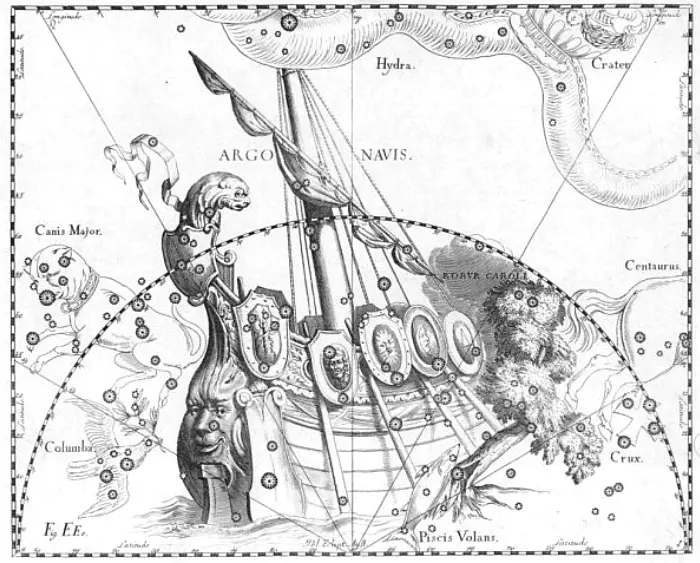
The constellation of Argo Navis from Firmamentum Sobiescianum, sive Uranographia (1690) by Johannes Hevelius. The view is mirrored following the tradition of celestial globes, showing the celestial sphere in a view from “outside.”
Stars
Argo Navis had more than 160 easily visible stars which were later assigned to the constellations Carina, Vela, and Puppis. The constellation had 15 stars brighter than magnitude 3.0, including Canopus, the second-brightest star in the sky (after Sirius). Canopus marked the helm of Argo and represented the ship’s helmsman Canopus (or Canobus). (The star’s name is typically associated with Canobus, the helmsman of Menelaus’ ship in the tale of Troy.)
The bright stars of Carina, Puppis and Vela still have the Greek letter designations assigned to them by Nicolas Louis de Lacaille, who replaced the original Bayer designations with ones that reflected the order of magnitude more closely. Even though he divided Argo, Lacaille used a single Greek-letter sequence for all three constellations, followed by “Argûs in carina,” “Argûs in puppi,” and “Argûs in velis.”
The designations Alpha and Beta went to the bright Canopus and Miaplacidus in Carina, Gamma and Delta went to Regor and Alsephina in Vela, Epsilon to Avior in Carina, and so on. Naos, the brightest star in Puppis, has the Bayer designation Zeta Puppis.
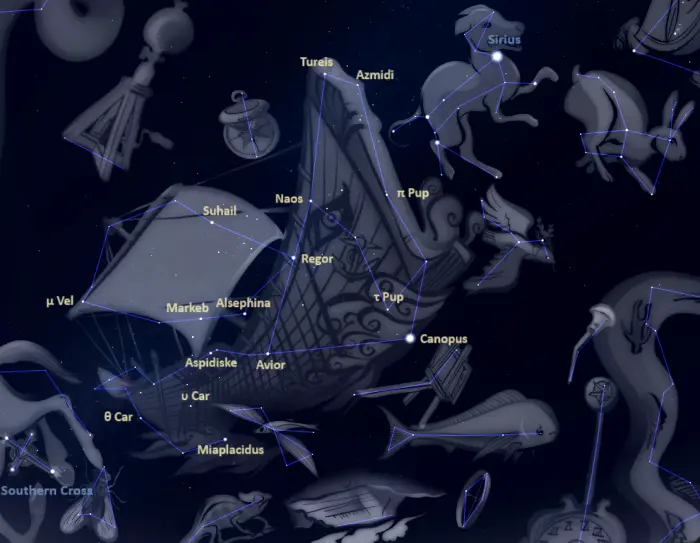
Argo Navis stars, image: Stellarium
The brightest stars in Argo Navis were:
| Name | Bayer designation | Apparent magnitude | Spectral type | Distance (light-years) |
| Canopus | Alpha Carinae | -0.74 | A9 II | 310 |
| Miaplacidus | Beta Carinae | 1.69 | A1 III | 113.2 |
| (Regor) | Gamma2 Velorum | 1.83 | WC8 + O7.5III | 1096 |
| Avior | Epsilon Carinae | 1.86 | K3 III + B2 Vp | 610 |
| Alsephina | Delta Velorum | 1.96 | A1 Va(n) + F7.5 V | 80.6 |
| Aspidiske | Iota Carinae | 2.21 | A9 Ib | 690 |
| Suhail | Lambda Velorum | 2.21 | K4 Ib | 545 |
| Naos | Zeta Puppis | 2.24 – 2.26 | O4If(n)p | 1080 |
| Markeb | Kappa Velorum | 2.48 | B2 IV | 570 |
| Mu Velorum | 2.69 | G5III + G2V | 112 | |
| (Ahadi) | Pi Puppis | 2.733 | K3 Ib | 810 |
| Theta Carinae | 2.76 | B0.5 Vp | 460 | |
| Tureis | Rho Puppis | 2.78 | F5IIkF2IImF5II | 63.5 |
| Tau Puppis | 2.95 | K1 III | 174 | |
| Upsilon Carinae | 2.97 | A8 Ib + B7 III | 1400 |
Facts
Puppis is the largest of the three modern constellations that constituted Argo Navis. It has an area of 673 square degrees. Vela and Carina are smaller and similar in size, occupying 500 and 494 square degrees respectively.
The constellations bordering Argo Navis were Antlia (the Air Pump), Canis Major (the Great Dog), Centaurus (the Centaur), Chamaeleon, Columba (the Dove), Hydra (the Water Snake), Monoceros (the Unicorn), Musca (the Fly), Pyxis (the Compass), Pictor (the Easel), and Volans (the Dolphinfish).
The constellation name Argo Navis is pronounced /ˈɑːɡəʊ ˈneɪvɪs/. In English, the constellation was known as Argo Navis or the Ship Argo. The genitive form of the name, used in star names, was Argus Navis (Argūs Navis). The commonly used three-letter abbreviations were Arg and Nav.
Argo Navis was one of the constellations listed in the Phenomena of Eudoxus of Cnidus (c. 390 – 340 BCE), the earliest Greek astronomy source, but the constellation predates Eudoxus. It was already known in Homer’s time and likely dates to the Heroic era of the Bronze Age, around 2000 BCE.
Argo was mentioned in the Astronomica, a Latin didactic poem in five books written by Roman poet and astrologer Marcus Manilius circa 30 – 40 CE. Manilius wrote, “Then famed Argo, raised to the skies from the sea which it was the first to cross, occupies the heaven it earned through grievous perils in a bygone age, made a god for having given safety to gods.” Like Ptolemy, Manilius was able to see the constellation from Rome.
The French astronomer Nicolas Louis de Lacaille divided Argo Navis into Carina, Puppis and Vela in his 1755 catalogue. Lacaille studied the southern sky from the Cape of Good Hope in South Africa from 1750 to 1754. He created 14 of the modern 88 constellations, including Antlia (the Air Pump), Caelum (the Chisel), Fornax (the Furnace), Mensa (Table Mountain), Octans (the Octant), Reticulum (the Reticle), and Telescopium (the Telescope).
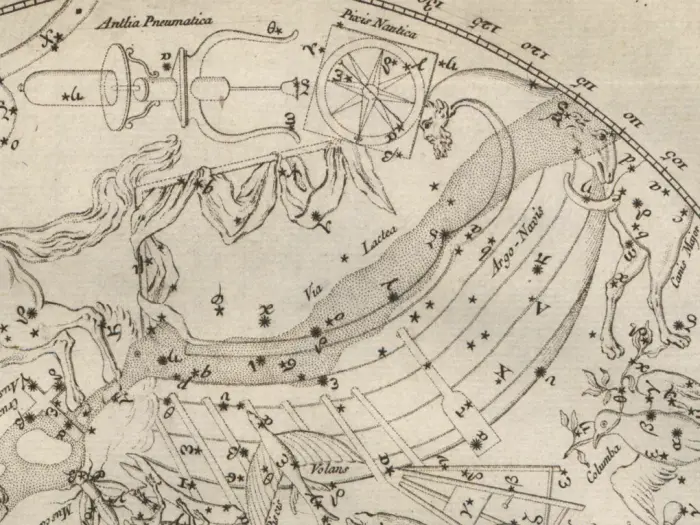
Argo Navis in Coelum Australe Stelliferum by Nicolas Louis De La Caille (1763)
Even though some believe that Pyxis, representing the mariner’s compass, was part of Argo, this was never the case. In ancient Greece, the four main stars of Pyxis were seen as the mast of Argo. Originally called Pyxis Nautica, the constellation was introduced by Lacaille next to Argo in the 1750s.
The obsolete constellation Malus (the Mast) appeared on some early 20th century charts as part of Argo Navis. However, most cartographers treated it as an asterism within the larger constellation and not as a separate constellation. Lacaille also defined Malus as part of Argo Navis.
English astronomer John Herschel proposed replacing Pyxis with the constellation Malus (the Mast) in 1844. Malus would have been a fourth subdivision of Argo. However, the idea was not widely accepted and the constellation Pyxis is now one of the 88 official constellations, while Malus is obsolete.
Another former constellation associated with Argo is Lochium Funis (the Log and Line). Lochium Funis was created by German astronomer Johann Bode in 1801 around Pyxis. The constellation represented a nautical device used to measure distance and speed. Like Malus, the constellation is now obsolete. Bode did not include Malus on his star maps.
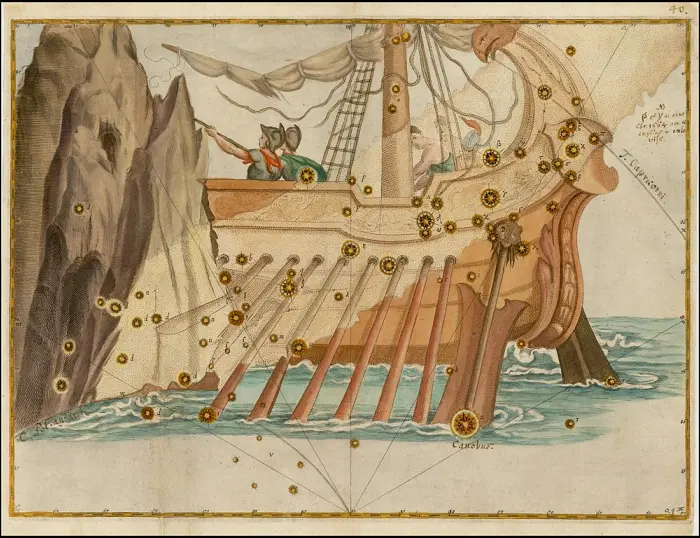
Argo Navis in Johann Bayer’s Uranometria (1603)
Map
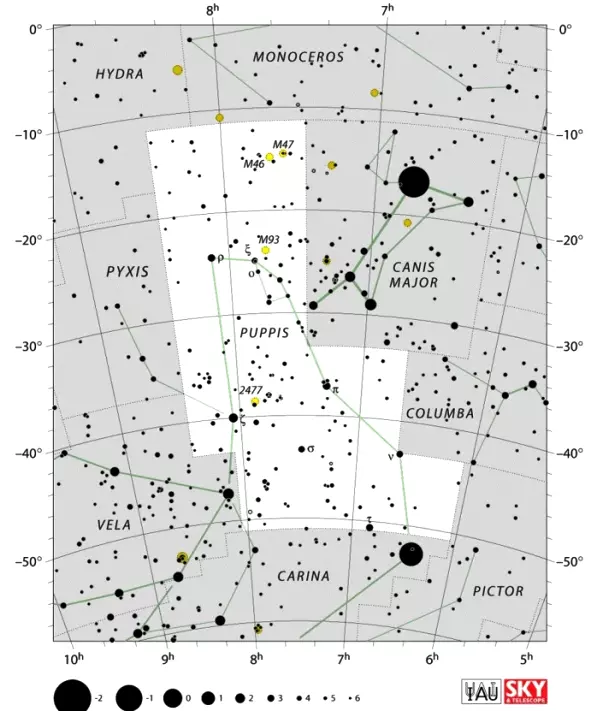
Puppis constellation map by IAU and Sky&Telescope magazine (Roger Sinnott & Rick Fienberg) (CC BY 4.0)
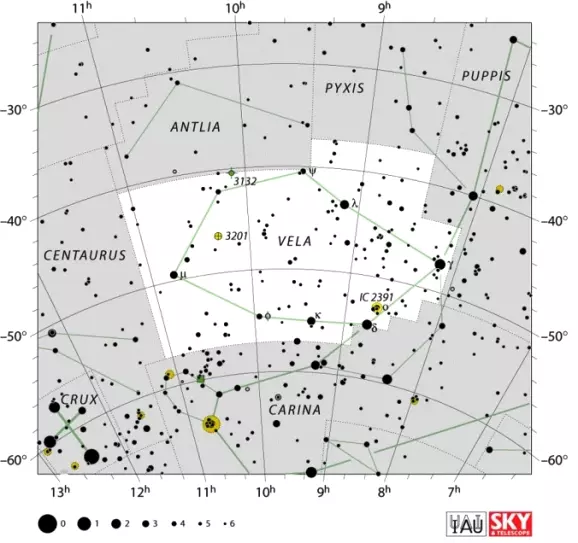
Vela constellation map by IAU and Sky&Telescope magazine (Roger Sinnott & Rick Fienberg) (CC BY 4.0)
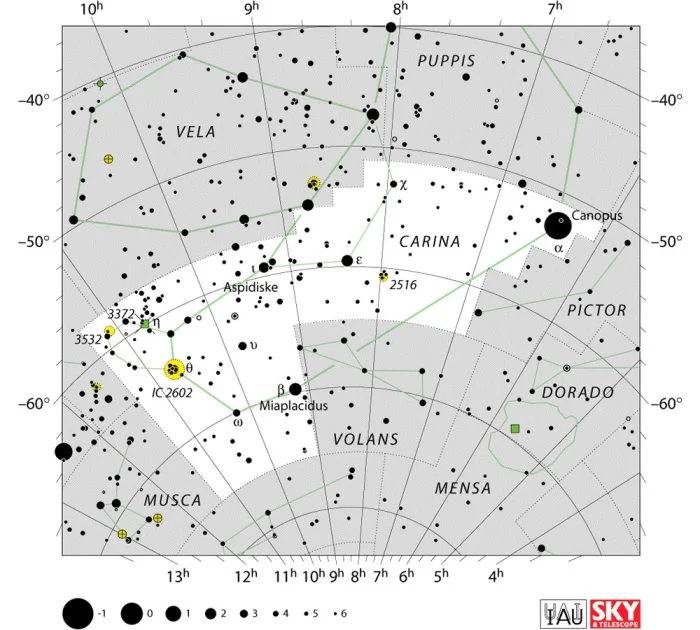
Carina constellation map by IAU and Sky&Telescope magazine (Roger Sinnott & Rick Fienberg) (CC BY 4.0)
Location
Argo Navis occupied a large area of the sky southeast of Canis Major (the Great Dog). The celestial ship (the three smaller constellations that constitute it) appears on the Milky Way and takes up much of the sky between the Canis Major triangle formed by Adhara, Wezen and Aludra and the bright stars of the Southern Cross.
Puppis, the northernmost of the three constellations, appears south and east of Canis Major. The entire constellation is visible from locations south of the latitude 40° N. The southernmost part of Vela can be seen from locations south of the latitude 30° N, while Carina is visible south of the latitude 20° N.
The best time of the year to see the stars and deep sky objects of Argo Navis is during February and March, when the obsolete constellation appears higher above the horizon in the early evening. The entire constellation is visible from locations south of the latitude 20° N.
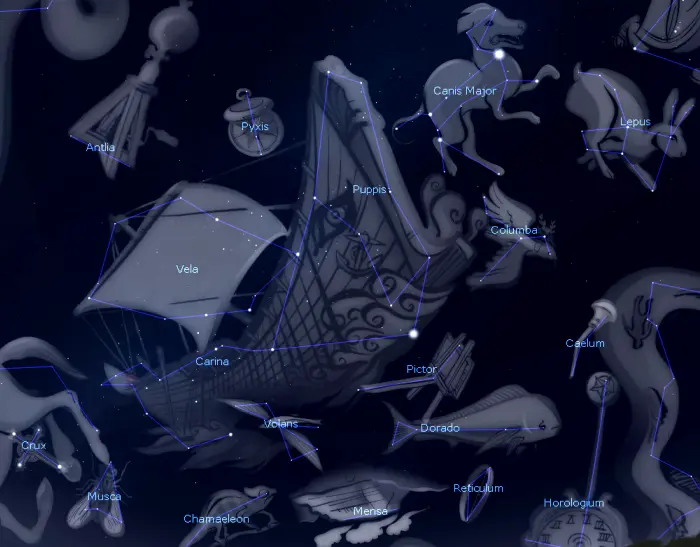
The location of Argo Navis, image: Stellarium